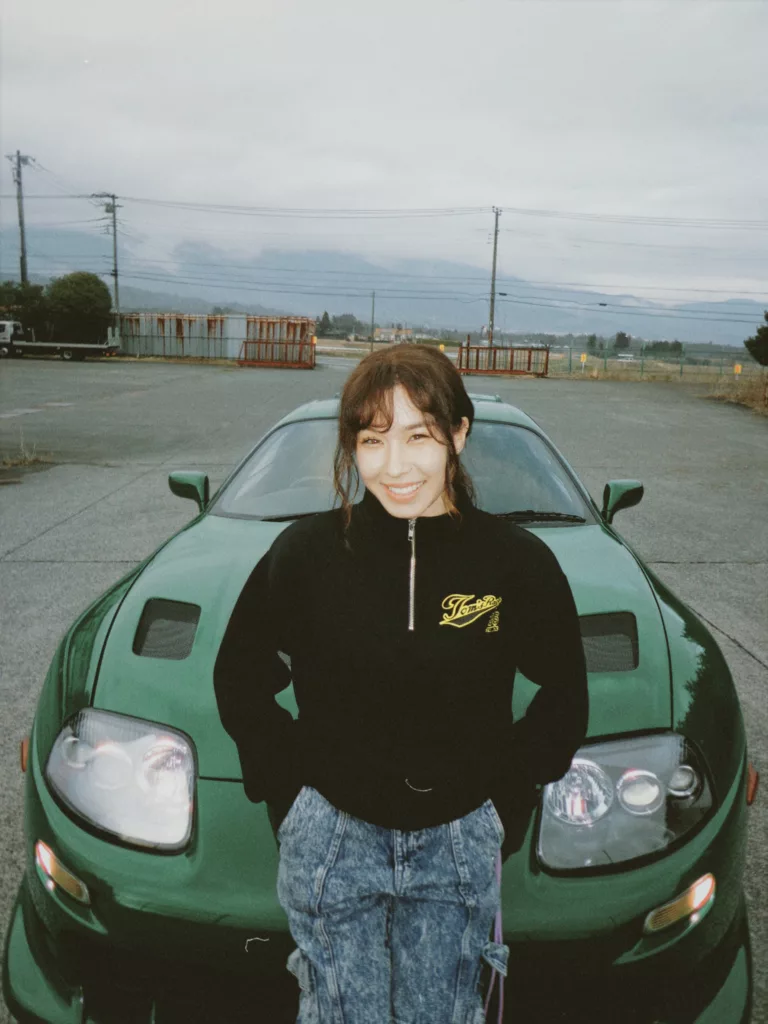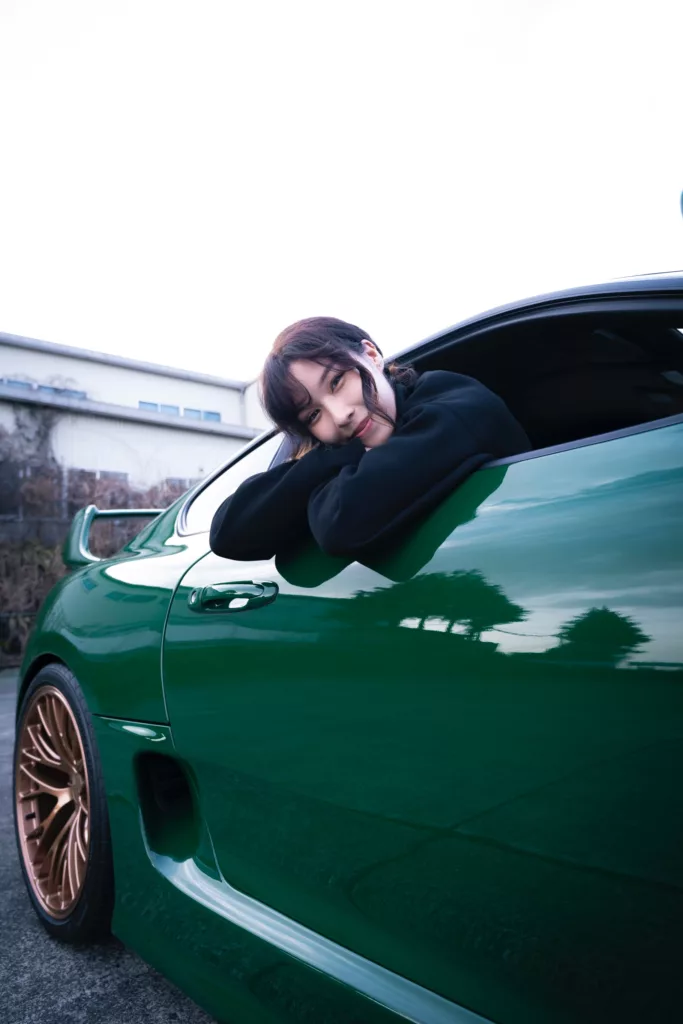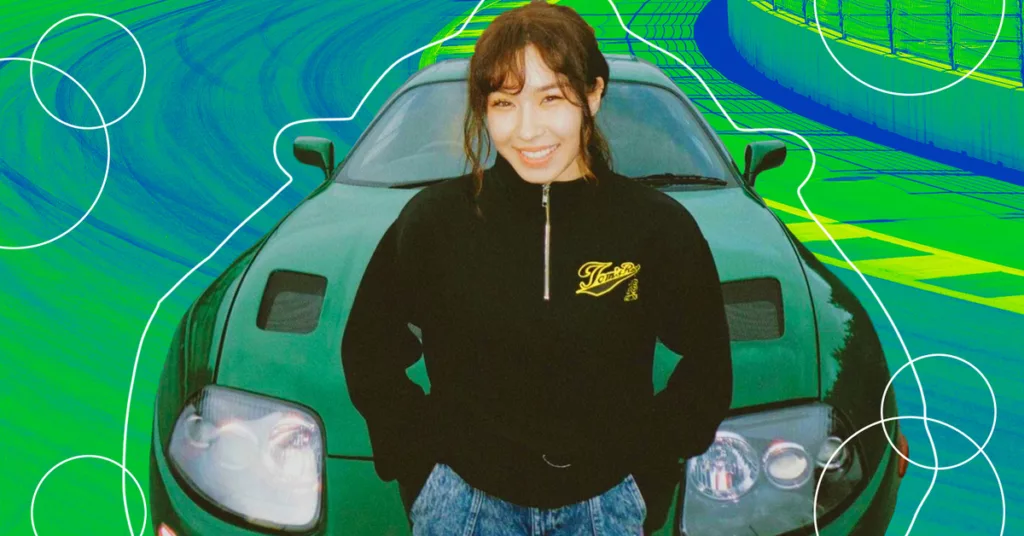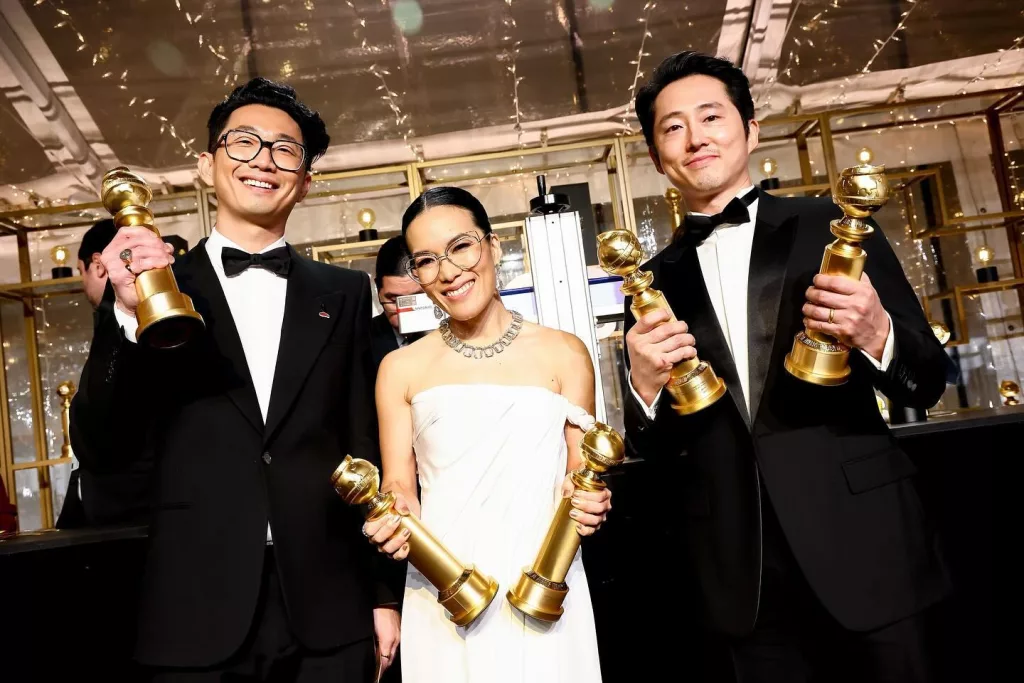Hana Burton wants to show people that she can be a competitive driver.
While most competitive racers we see today started karting at eight years old (with some racers starting as early as five years old), Burton began racing in her twenties. “I want to show people that with perseverance and relentless effort, even without the advantages of family support in early exposure to karting, or extensive financial backing, I can be a competitive driver,” she wrote to EnVi.
Hana Burton is a Japanese American racer and content creator currently based in Tokyo, Japan. She debuted at the 2022 Toyota Gazoo Racing Yaris Cup where she won Rookie of the Year. Since then, she has gone on to race in the Kyojo Cup, Fuji Championship series, and the 2023 Global Time Attack Finals in Los Angeles, California. Burton strives to make motorsports more accessible to the greater public by sharing her racing journey and lifestyle in Japan. She’s amassed over 400,000 followers on Instagram and 1.4 million likes on TikTok. She was the official English commentator for the Super Taikyu Series in 2022 and has previously partnered up with brands like ENEOS, Acura, and GoodYear.
EnVi spoke with Burton over email in-between her attendance at the FORMULA 1 Miami Grand Prix and her race weekend at the Fuji Championship series and Kyojo Cup. We talked about her racing journey thus far, how she met her current team, and the mark she wants to leave on motorsports — and the world.


Shifting Gears
Hana Burton’s first race car was HKS’s Supercharged FRS. Previously, she had worked in the marketing department of HKS, a Japan-based company specializing in aftermarket automotive parts and accessories. With HKS being a relatively small company, Burton wore many hats while a part of their team. “I found myself not only managing marketing tasks and social media but also overseeing the website and crafting product descriptions,” she explained. “This required extensive research into cars and tuning parts, learning their functionality and installation processes.”
In order to complete her research and keep up with marketing trends, she attended car shows with her colleagues. Burton recalled SEMA and the Tokyo Auto Salon being the two pivotal events that hooked her into cars and racing. Soon, she found herself working on demo cars with her team after hours. “It was a collaborative effort to ensure the cars were ready for showcasing at such prestigious automotive events,” she said. On the side, Burton would practice driving with HKS’s Supercharged FRS.
Burton’s first track day was at Chuckwalla Valley Raceway in California. She recalled saving up her paychecks to sign up for more track days and would attend once a month. Burton was committed to improving her racing and started to keep a binder to track her progress.
Soon, she started participating in time attacks where racers compete for the fastest lap. She raced in the TRD Series Honda Time Attack Challenge as well as multiple out-of-state global time attacks.
Rookie of the Year
However, Burton felt as though she wasn’t learning enough from only participating in time attacks. She knew that if she wanted to progress in racing, she needed to get a license. Originally, she considered testing for an American racing license, but costs can run over a few thousand dollars. After much research, she discovered that licenses in Japan only cost a couple hundred dollars.
During this time, Burton met Japanese racer Arisa Mizuhara who was in America for an event. She had mentioned to the racer that she was interested in the Toyota Gazoo Yaris Cup. By a stroke of luck and fate, Arisa knew a person at TRD who invited Burton to check out the race in the coming week. Burton recalled “dropping everything” to book a flight to Tokyo and Hokkaido.
On race week, she met with the team at Goodyear who offered her a seat on their team at the end of the year. While exciting, this meant that Burton only had a few weeks to prepare for her racing license. Arisa helped arrange a competition test at Sodegaura Forest Raceway, and just before the Toyota Gazoo Yaris Cup, Hana Burton obtained her Japanese racing license.
Nonetheless, it wasn’t smooth sailing from there. In preparation for the race, Burton had to learn “right-hand drive, driving in close proximity with other cars, and racecraft.” She was racing in a car she’s never driven before on a track that was completely new to her. Despite her initial struggles, Hana Burton emerged victorious and won the 2022 Toyota Gazoo Rookie of the Year Award.
213
After a successful and electrifying debut, Burton faced her next challenge head on: how to continue racing. After meeting the first Japanese Le Mans winner, Masanori Sekiya at the Tokyo Auto Salon, Burton received an invitation to audition for a seat in the Inter Proto Series Kyojo Cup, an all women’s race. Athletes race with cars called VITA-01 which is an open cockpit car. If Burton succeeded in landing a seat on one of the teams, she would be racing against those who have been karting since they were children, with some even racing in Formula 4 and Formula 3.
“Wanting to prepare adequately, I rented a car to test at Tsukuba 1000 before the audition,” she told EnVi. The rental cars came with GoPros to record drivers’ racing which allowed them to pinpoint weaknesses and mistakes they made while practicing. After Burton had finished her practice, the people at the rental sent her driving footage to a team who were looking for a new driver. Within a day, the team contacted Burton and offered her a seat without an audition.
Burton vividly recalls her first test day with the team on February 13, 2023. “It was pouring rain to the point where my (now) coach had stopped driving due to the dangerous conditions,” she said. On top of that, the driver whom Burton was sharing the VITA-01 with had crashed earlier that morning which means she couldn’t test drive the car. The team decided to put her into a FIA Formula 4 car.
“I never thought I’d have an opportunity to drive a formula car,” she admitted. But when she drove in the rain and came back full throttle, she knew formula racing was the path for her. Burton recalled crying happy tears when she returned to the pit lanes. This test day played a monumental role in Hana Burton’s racing journey and became the reason why her race number is 213.
Funding a Race Career
Burton has been outspoken about the financial help required to pursue a racing career. In response to an Instagram comment, she outlined the ways one can secure funding for their career including creating a sponsorship deck, content creation, and more. She doesn’t shy away from her struggles as an up-and-coming racer, and instead uses her platform to empower others.
During her first year as a racer, Burton moved into the second floor of her mechanic’s car shop in Kyoto. “Living in the shop was not only a matter of budgeting but also of convenience. Being close to the team allowed me to be readily available to help with various tasks, such as loading and preparation for racing events,” she further explained. “This experience provided me with a deeper understanding of the behind-the-scenes efforts required for me to pursue my passion for racing.”
She also lived in an RV for some time afterwards. While she has since moved into an apartment, Burton looked back on her journey and reflected, “The time spent in those unconventional living spaces was instrumental in shaping my perspective.” Her experiences taught her to “appreciate the opportunities afforded to [her] and not take them for granted.”
“It was a humbling experience that instilled in me a greater sense of gratitude and respect for the collaborative nature of motorsport,” Burton said fondly.
When asked if she had any financial advice for aspiring racers, she said, “It’s crucial to network extensively within the industry. Personally, knowing people in Japan influenced my decision to move here to pursue racing, also considering the lower costs compared to the USA.” Then she further explained that “in this cutthroat industry, seizing every opportunity and giving your utmost effort is essential for success. I’ve been fortunate to receive incredible support from my team and leverage social media reach to secure sponsorships, which has been instrumental in enabling me to pursue racing.”
“It’s a tough journey, with many needed sacrifices,” Burton admitted. “But perseverance and maximizing every available resource are key to breaking into the sport despite financial constraints. There’s no one path to pursue, you have to find what works for you.”
Making Motorsports Accessible
Recently, Hana Burton gave a career talk at City Circuit Tokyo Bay for Formula E’s Girls on Track event. “I’m incredibly grateful for the opportunity to represent women drivers in Japan at such a significant event, especially considering my newcomer status in the Japanese motorsport scene,” she wrote.
Burton saw the experience as “eye-opening” and she witnessed the “extent of influence” she had as a woman racer in Japan. “It was heartening to see so many young girls [be] passionate about motorsports,” she went on to explain. “One girl even traveled from outside of Japan solely for the event, showing such a strong dedication to pursuing opportunities in motorsport.”
However, this wouldn’t be the first time Burton opened up about her career and journey as a racer. She uses her social media platform to document her journey and improvement as a competitive racer. She’s previously shared a five-part series on Instagram and TikTok about how she discovered motorsports, and has actively been open about her progress.
The experience at City Circuit Tokyo Bay only “further motivated me to work harder, knowing that these girls view me as a role model for navigating careers in a male-dominated space,” Burton said.


The Path to Formula Racing
This year, Hana Burton is racing in the Fuji Championship series and the Kyojo Cup. In preparation for her Formula 4 debut, she is also currently training in an Oscars RS and FIA Formula 4 car. When asked when she’ll know she’s “made it,” Burton answered, “Finishing first in one of [these] race series against these experienced drivers.” She further explained that “with 30 cars in Kyojo Cup and 42 cars in Fuji Championship Series, the competition is tight and it would help me feel like all of the hard work is paying off and I’m moving in the right direction.”
While she has her eyes set on first place, Burton also wants to show people that she can be a competitive driver. “I want my journey to be a testament to the idea that hard work and love for what you’re doing can overcome any obstacle,” Burton told EnVi. “Hopefully as I progress, I can inspire others to pursue their passions fervently, regardless of their background, and show them that with determination, they, too, can carve out their own path to success in motorsports and beyond.”
You can follow Hana Burton on Instagram, X, and TikTok as well as subscribe to her YouTube channel to keep up with her racing journey and lifestyle content.
*Editor’s Note: This interview has been lightly edited for length and clarity.
Want to learn more about women racers like Hana Burton? Check out our article on Reema Juffali here!




